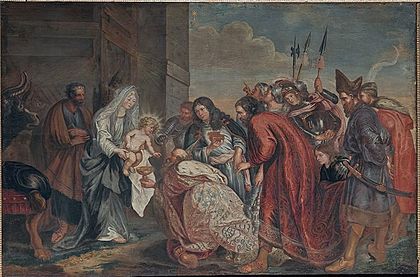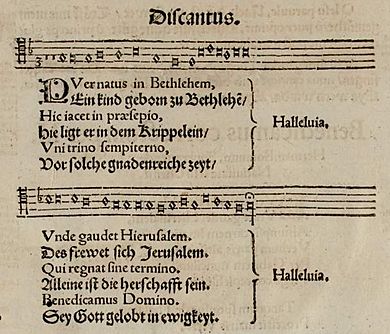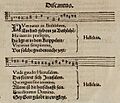Sie werden aus Saba alle kommen, BWV 65 facts for kids
Quick facts for kids Sie werden aus Saba alle kommen |
|
|---|---|
| Church cantata | |

Michael Angelo Immenraet: Adoration of the Magi at Unionskirche, Idstein, from the 1670s
|
|
| Occasion | Epiphany |
| Performed | 6 January 1724: Leipzig |
| Movements | 7 |
| Vocal |
|
| Instrumental |
|
Sie werden aus Saba alle kommen (which means "They will all come forth out of Sheba") is a special type of music called a church cantata. It was written by the famous composer Johann Sebastian Bach. This piece is also known as BWV 65.
Bach created this cantata in 1724 while he was living in Leipzig, Germany. He wrote it for a Christian holiday called Epiphany. The very first performance of this cantata was on January 6, 1724. It was part of his first series of cantatas for the church year.
The words for the cantata were written by someone whose name we don't know. The text combines ideas from the Book of Isaiah and the Gospel of Matthew. These parts of the Bible talk about a prophecy and the story of the Wise Men from the East. The Wise Men brought gifts to baby Jesus.
The cantata's story begins with a quote from the Bible's prophecy. It then includes a verse from an old Christmas carol called "Ein Kind geborn zu Bethlehem". The music then tells how the prophecy came true in Bethlehem. It ends by saying that Christians should offer their hearts as a gift. The cantata finishes with a chorale, which is like a hymn.
Bach used many instruments for this cantata. It features two solo singers (a tenor and a bass) and a four-part choir. The orchestra includes two horns, two recorders, two oboes da caccia, strings, and a basso continuo.
What is a Cantata?
A cantata is a type of musical piece that usually involves singing. It can be for a choir, solo singers, and instruments. Bach wrote many church cantatas for Sunday services and special holidays. They often told a story or shared a message based on Bible readings.
History and Story of the Cantata
When did Bach Write This Cantata?
Bach composed Sie werden aus Saba alle kommen in 1724. This was his first year as the Thomaskantor in Leipzig. The Thomaskantor was the director of church music at the St. Thomas Church. This cantata was the last piece he wrote for his first Christmas season in Leipzig.
For the Christmas season that year, Bach had already performed several other cantatas:
- Christen, ätzet diesen Tag, BWV 63
- Darzu ist erschienen der Sohn Gottes, BWV 40
- Sehet, welch eine Liebe hat uns der Vater erzeiget, BWV 64
- Singet dem Herrn ein neues Lied, BWV 190
- Mein liebster Jesus ist verloren, BWV 154
He also performed his Magnificat and a new Sanctus.
What is the Story Behind the Words?
The readings for Epiphany came from the Book of Isaiah and the Gospel of Matthew. Isaiah talks about people from other lands converting to faith. Matthew tells the story of the Wise Men from the East bringing gifts. These gifts were gold, myrrh, and frankincense for the baby Jesus.
The person who wrote the words for the cantata might have also written the words for two other Christmas cantatas (BWV 40 and BWV 64). This writer was very good at theology (religious study) and poetry. The cantata starts with a verse from Isaiah's prophecy. It says that "all they from Sheba shall come: they shall bring gold and incense."
This prophecy is then connected to a chorale (hymn) verse. This verse is from an old Christmas carol called "Ein Kind geborn zu Bethlehem". It talks about the "Kings from Sheba" arriving. The cantata then explains that the gospel story is the fulfillment of this prophecy. It concludes that Christians should offer their hearts as a gift to Jesus.
The second part of the cantata compares the gifts of the Wise Men to gifts Christians can give today. Faith is like gold, prayer is like incense, and patience is like myrrh. The last song (aria) says that a devoted Christian offers their heart as a present. The cantata ends with a final hymn.
The Music of the Cantata
How is the Cantata Structured?
Bach organized this cantata into seven different parts, called movements. It starts with a big chorus, then a chorale. After that, the two solo singers (tenor and bass) each sing a recitative (a speech-like song) and an aria (a more melodic song). The whole piece finishes with another chorale.
Bach used a rich mix of instruments. He included two horns, two recorders, two oboes da caccia, two violins, a viola, and a basso continuo. The basso continuo is a group of instruments that provides the bass line and harmonies. Bach often used horns in his Christmas music.
Here is a simple look at the movements:
| No. | Title | Text | Type | Vocal | Winds | Strings | Key | Time |
|---|---|---|---|---|---|---|---|---|
| 1 | Sie werden aus Saba alle kommen | Isaiah | Chorus | SATB | 2Co 2Fl 2Oc | 2Vl Va | C major | 12/8 |
| 2 | Die Kön'ge aus Saba kamen dar | anon. | Chorale | SATB | 2Fl 2Oc | A minor | 3/4 | |
| 3 | Was dort Jesaias vorhergesehn | anon. | Recitative | B | ||||
| 4 | Gold aus Ophir ist zu schlecht | anon. | Aria | B | 2Oc | E minor | ||
| 5 | Verschmähe nicht, du, meiner Seele Licht | anon. | Recitative | T | ||||
| 6 | Nimm mich dir zu eigen hin | anon. | Aria | T | 2Co 2Fl 2Oc | 2Vl Va | C major | 3/8 |
| 7 | Ei nun, mein Gott, so fall ich dir | Gerhardt | Chorale | SATB | 2Co 2Fl 2Oc | 2Vl Va | A minor |
What Do the Movements Sound Like?
Bach used the instruments to show differences between poverty and richness. For example, the first aria (song) only uses oboes da caccia in a low sound. This helps show the idea of humility. But for the opening chorus, the last aria, and the closing chorale, he used the full, festive orchestra.
1. The Opening Chorus
The first part, "Sie werden aus Saba alle kommen", is a chorus. It sounds like everyone is gathering and moving to worship. You can hear horn signals throughout the piece. The music builds up, like a crowd growing larger. It has a big choral fugue in the middle. Some people think the instruments sound like music from the Near East.
2. The Christmas Carol
This movement, "Die Kön'ge aus Saba kamen dar", is a verse from an old Christmas carol. It tells about the kings from Sheba. The melody is in triple time and is sung by four voice parts.
3. The First Recitative
The third movement, "Was dort Jesaias vorhergesehn, das ist zu Bethlehem geschehn.", is a recitative. It connects the prophecy from Isaiah to what happened in Bethlehem. It tells Christians that their heart is the only gift they have to offer. The music has some surprising harmonies when it talks about the humble stable where Jesus was born.
4. The First Aria
The fourth movement, "Gold aus Ophir ist zu schlecht", is an aria. It is sung by the bass soloist and accompanied by the low-sounding oboes da caccia. This helps show the idea that gold is not good enough. The instruments keep repeating a musical idea, reminding us that gold is not the best gift.
5. The Second Recitative
The tenor soloist sings the fifth movement, "Verschmähe nicht, du, meiner Seele Licht, mein Herz". It starts with a plea, asking not to scorn the heart. It ends with the idea that the greatest wealth will be in Heaven.
6. The Second Aria
The sixth movement, "Nimm mich dir zu eigen hin", is a lively, dance-like aria. All the wind instruments play together in this part. It shows the idea of abundance. The music is very varied and colorful.
7. The Closing Chorale
The cantata ends with the chorale, "Ei nun, mein Gott, so fall ich dir getrost in deine Hände.". This hymn is sung to a melody that Bach used often in his other works.
Images for kids
See also
 In Spanish: Sie werden aus Saba alle kommen, BWV 65 para niños
In Spanish: Sie werden aus Saba alle kommen, BWV 65 para niños




